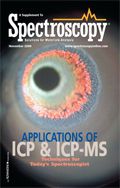Article
Special Issues
Spectroscopy Supplements
The Research Behind the Headlines
Author(s):
Editor letter on ICP and ICP-MS
Safer drinking water. Lead paint in toys. Cleaner-burning gasoline. These could be the headlines on your favorite website on any given day of the week, as each of these issues has captured the attention of the media and the world at large in recent years. They've affected the daily lives of each and every one of us at some point, whether we fished through our children's toys after the most recent lead paint scare, or boiled water like many in New York City did during a recent contamination.
However, these life-affecting issues have one more important thing in common, and that is the fact that they are covered here in the November 2009 edition of Spectroscopy's annual ICP/ICP-MS supplement. Disseminating research that makes the world a better place has long been at the core of Spectroscopy's editorial mission, and there may be no better example of this than the supplement you are now reading. Here you will find practical, real-world examples of spectroscopy improving — and even saving — lives. For many of us, when a law is passed mandating lower levels of toxins in drinking water or cleaner-burning gasoline, we assume it just happens overnight. But here in this supplement, you will find the actual research behind the headlines, and see the everyday work that must be done once laws are enacted and regulations passed.
As always, we hope you enjoy this supplement and find it useful in your everyday work. We are proud to bring you this research from the front lines of materials analysis, and perhaps the next time our nightly cable news programs bring us a breaking story on a lead paint scare, or contaminated drinking water, or legislation aimed at reducing emissions, we will remember these individuals doing the real-world research that makes the world a better place.
David Walsh
Editor-in-Chief

Newsletter
Get essential updates on the latest spectroscopy technologies, regulatory standards, and best practices—subscribe today to Spectroscopy.



